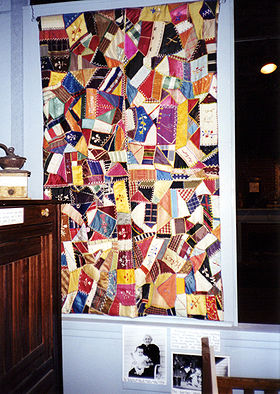
Crazy quilting
Encyclopedia

Textile art
Textile art may refer to:*Any one of the textile arts, those arts and crafts that use plant, animal, or synthetic fibers to construct practical or decorative objects*Fiber art, the creation of fine art using textile arts techniques and materials...
of crazy patchwork and is sometimes used interchangeably with that term. Crazy quilting does not actually refer to a specific kind of quilting
Quilting
Quilting is a sewing method done to join two or more layers of material together to make a thicker padded material. A quilter is the name given to someone who works at quilting. Quilting can be done by hand, by sewing machine, or by a specialist longarm quilting system.The process of quilting uses...
(the needlework which binds two or more layers of fabric together), but a specific kind of patchwork
Patchwork
Patchwork or "pieced work" is a form of needlework that involves sewing together pieces of fabric into a larger design. The larger design is usually based on repeat patterns built up with different colored shapes. These shapes are carefully measured and cut, straight-sided, basic geometric shapes...
. Crazy quilts rarely have the internal layer of batting that is part of what defines quilting as a textile technique.
Combining the patches
Regular patchwork combines the pieces of fabric into a predetermined and regular design, but crazy patchwork uses irregular pieces of fabric on a foundation fabric or paper. This may create haphazard-looking and asymmetrical designs, or the designer may use some control in placement.Patches can be hand appliquéd onto a base fabric. This method gives the most variety as every patch is unique. There are also block patterns designed for crazy quilt that can be sewn by machine.
Sometimes part of a crazy quilt is haphazard while other parts are placed in a planned pattern. A common example of this the placement of patches is a fan pattern.
The patches and seams are then usually heavily embellished.
Embellishing
Crazy quilts differ from "regular" quilts in other ways as well. Because the careful geometric design of a quilt block is much less important in crazy quilts, the quilters are able to employ much smaller and more irregularly-shaped pieces of fabric. In comparison to standard quilts, crazy quilts are far more likely to use exotic pieces of fabric, such as velvetVelvet
Velvet is a type of woven tufted fabric in which the cut threads are evenly distributed,with a short dense pile, giving it a distinctive feel.The word 'velvety' is used as an adjective to mean -"smooth like velvet".-Composition:...
, satin
Satin
Satin is a weave that typically has a glossy surface and a dull back. It is a warp-dominated weaving technique that forms a minimum number of interlacings in a fabric. If a fabric is formed with a satin weave using filament fibres such as silk, nylon, or polyester, the corresponding fabric is...
, tulle
Tulle
Tulle is a commune and capital of the Corrèze department in the Limousin region in central France. It is also the episcopal see of the Roman Catholic Diocese of Tulle...
, or silk
Silk
Silk is a natural protein fiber, some forms of which can be woven into textiles. The best-known type of silk is obtained from the cocoons of the larvae of the mulberry silkworm Bombyx mori reared in captivity...
, and embellishments such as buttons, lace
Lace
Lace is an openwork fabric, patterned with open holes in the work, made by machine or by hand. The holes can be formed via removal of threads or cloth from a previously woven fabric, but more often open spaces are created as part of the lace fabric. Lace-making is an ancient craft. True lace was...
, ribbons, beads, or embroidery
Embroidery
Embroidery is the art or handicraft of decorating fabric or other materials with needle and thread or yarn. Embroidery may also incorporate other materials such as metal strips, pearls, beads, quills, and sequins....
. Crazy quilting as a textile art is extremely creative and free-flowing by nature, and crazy quilters will often learn as much about specific embellishments as they will about crazy quilting itself.
History
Crazy quilting created a stir in the 1880's when it became quite a fad in the United States. The Japanese Exhibit in the 1876 Philadelphia Centennial Exposition inspired the crazy quilt with its asymmetrical art.Articles encouraging crazy quilting, or condemning it, could be found in women's publications. Women could purchase packages of random fabrics, as well as already embellished pieces, to use in their own crazy quilts.
During the first several years of the crazy quilting fad, fine fabrics and heavy embellishment were the norm. As time passed quilters began to make simpler quilts in the crazy quilt style. Thrifty housewives used everyday fabrics like wool or cotton and little or no embellishment to create more serviceable quilts than the original fancy crazy quilts with the added benefit of using up small or odd-shaped scraps left over from making clothing for the family or other household sewing projects.
External links
Examples of ways of combining patches in a crazy quilt:Learn more about crazy quilt history.
An example of a crazy quilt from the Smithsonian.
Modern crazy quilting
Sources
- 2008: Cindy Brick. Crazy Quilts: History, Techniques, Embroidery Motifs, Voyageur Press. ISBN 13-978076033-237-5
- 2000: Christine Dabbs. Crazy Quilting: Heirloom Quilts: Traditional Motifs and Decorative Stitches,Rutledge Hill Press. ISBN 1-55853-694-9.
- 1995: Judith Baker Montano. Elegant Stitches: An Illustrated Stitch Guide and Source Book of Inspiration, C&T Publishing. ISBN 0-914881-85-X.

